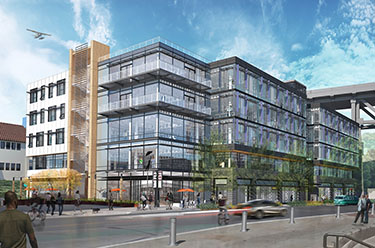|
Subscribe / Renew |
|
|
Contact Us |
|
| ► Subscribe to our Free Weekly Newsletter | |
| home | Welcome, sign in or click here to subscribe. | login |
Architecture & Engineering
| |
 |
October 29, 2015
Survey: Weber Thompson
Specialty: Architecture, interior design, landscape architecture, community planning
Management: Blaine Weber, senior principal
Founded: 1988
Headquarters: Seattle
2015 revenues: $15 million
Projected 2016 revenues: $16.5 million
Projects: Cirrus at 2030 Eighth Ave., with 355 apartments; Fremont Office Building, with 106,000 square feet of class A commercial office space
Blaine Weber answered questions about his firm and industry trends.
Q: What divisions of Weber Thompson have seen an uptick in work?
A: In the past year, the two sectors that have seen the most new growth in our firm are commercial office and affordable housing, along with continued steady growth in high-density residential and mixed-use projects in urban and suburban centers. We’ve increased our staff by 7.5 percent so far in 2015, adding production staff and infrastructure positions to support increasingly large and complex high-quality projects.
Q: Are you shifting the firm’s focus at all?
A: Weber Thompson continues to grow our commercial office, hospitality and affordable housing market sectors in addition to the market-rate housing work we are best known for. Although these are not new lines of business for us, there is an added emphasis on building them up as a greater percentage of our overall workload and portfolio. There is still plenty of work in market-rate housing but we believe the diversification is good for the longterm health of the firm for several reasons.
Q: What design trends have resulted from end-user requests?
A: We talk a lot about end-user desires/expectations in our various design studio discussions — it is back-seat-driving the design boat on many levels.
Regarding residential, I would have to say that end-user expectations for the “third place” continues to top the charts. Millennials are willing to live with much less space — provided that the amenity/hiving spaces are top shelf, and that they are designed to facilitate social activity in a meaningful way.
With hotels, there is a desire for a more residential feel; more focus on the healthy lifestyle guest experience and in connecting to “local” as opposed to being generic across the country.
With commercial office, we are seeing speculative developers embrace sustainability in a surprisingly big way as a means to help ensure success.
Q: What trends are on the horizon and will business continue to be strong?
A: We are seeing a continued geographic expansion of the strong building market — increasing in Bellevue, Kirkland and Redmond, then potentially expanding north and south to Bothell and Renton. More urban commercial office and affordable housing projects are coming through our office and we expect that to continue through 2016 and beyond. For us, this should translate into a relatively strong 2016 through a wide mix of project types and locations, but being in operations I like to stay conservative in my forecasting.
Other Stories:
- Architects are the QB; meet the rest of the team
- Survey: Freiheit & Ho Architects
- Survey: BCE Engineers
- Survey: NAC Architecture
- Survey: ESM Consulting Engineers
- Survey: Davido Consulting Group
- Survey: Studio 19 Architects
- Installing an AV system? Try your IT network
- Dramatic tax change is good for in-state A&E firms
- A closer look at Seattle’s new NBA/NHL arena
- Seattle Pacific University retro-commissions 25 buildings
- What is Seattle's hot new neighborhood? LoSto
- A step-by-step guide to selecting a virtual design partner
- Group polishes guidelines for design-build projects
- Survey: Karen Kiest Landscape Architects



